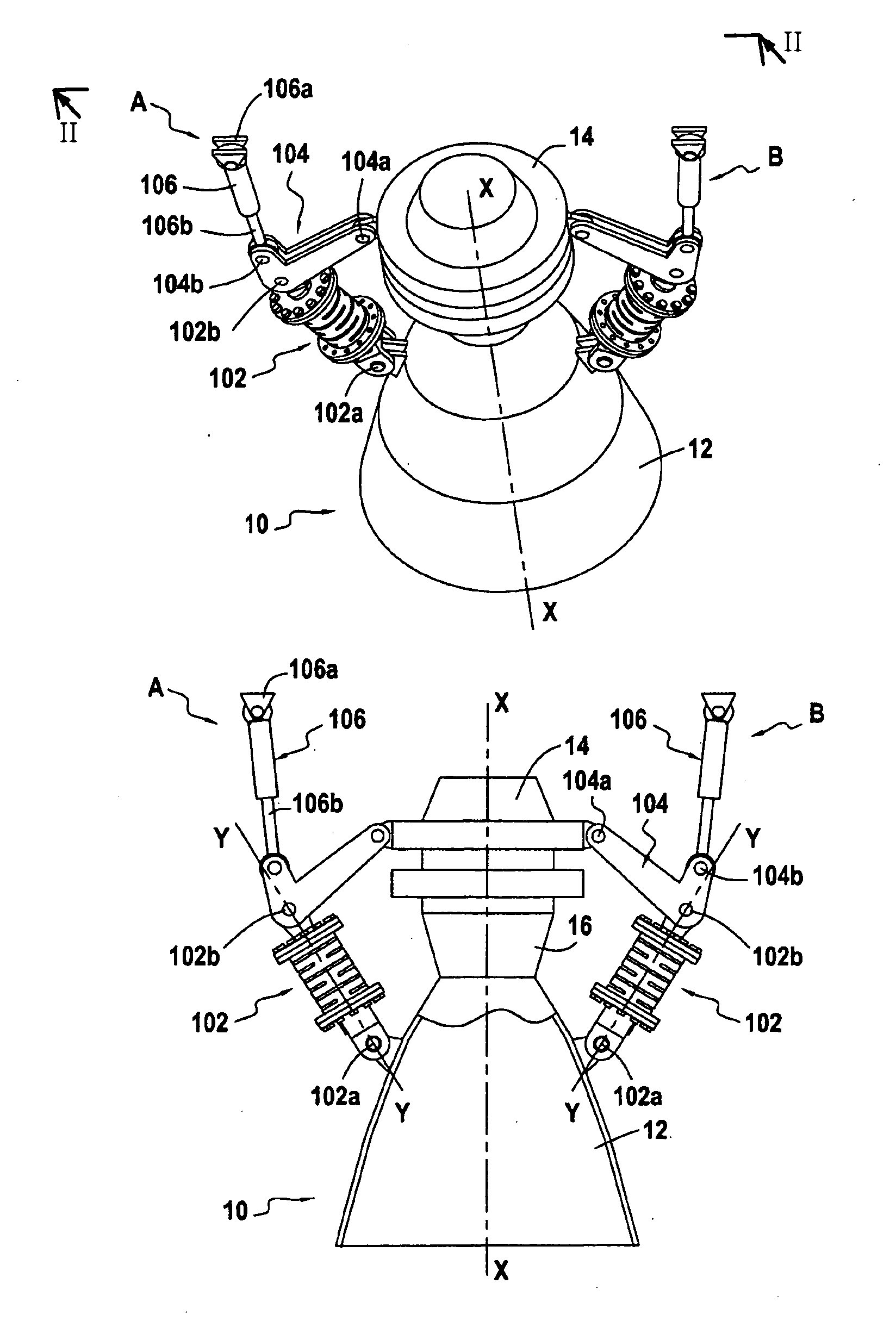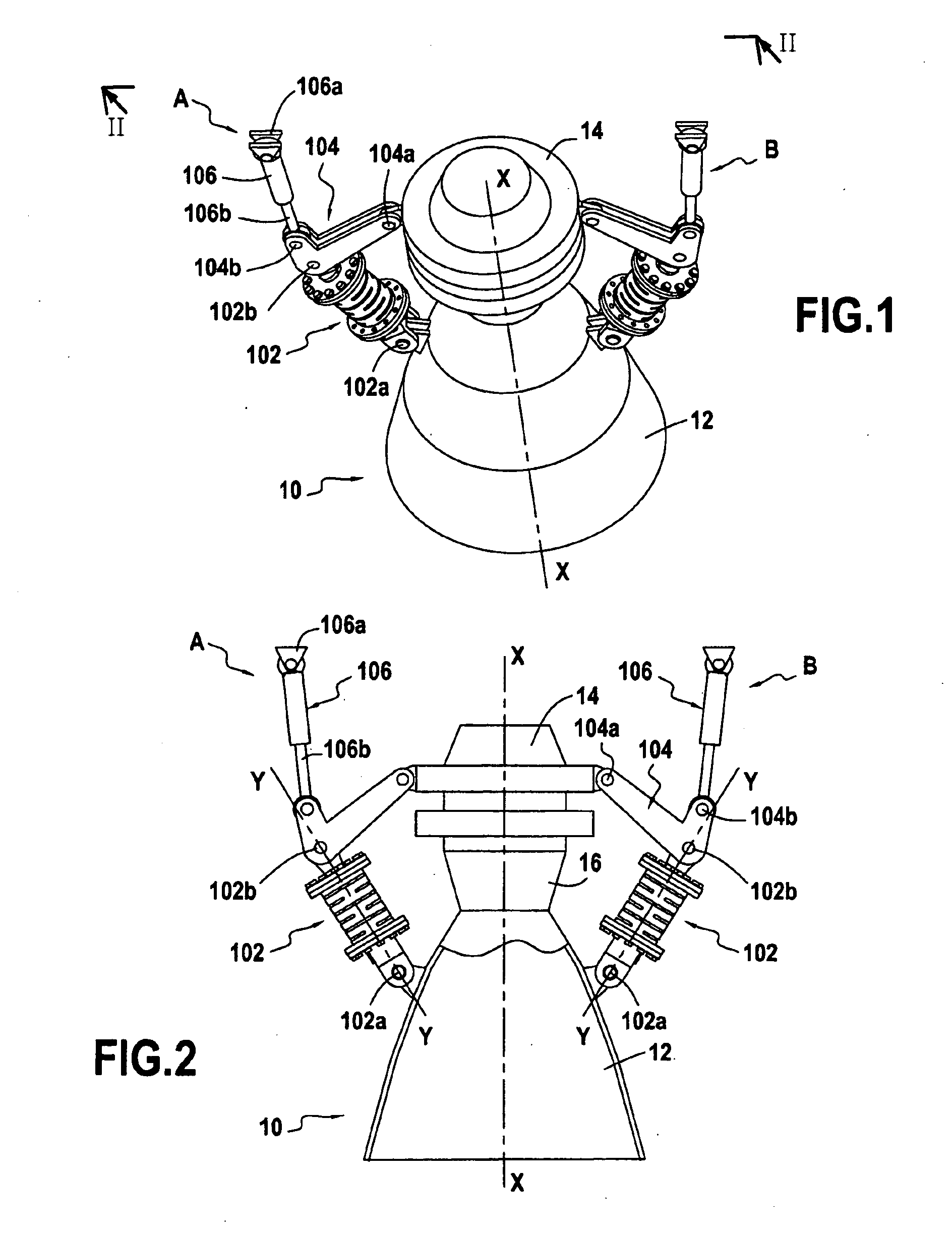Device for damping the lateral forces due to jet separation acting on a rocket engine nozzle
a technology of jet separation and lateral force, which is applied in the direction of vessel construction, marine propulsion, aircraft navigation control, etc., can solve the problems of limiting the level of force that is transmitted to the structure and dissipating residual kinetic energy
- Summary
- Abstract
- Description
- Claims
- Application Information
AI Technical Summary
Benefits of technology
Problems solved by technology
Method used
Image
Examples
first embodiment
[0037]In a first embodiment, shown in FIGS. 1, 2, 3, 4A, and 4B, each strut 102 of the drive assemblies comprises a tube 108 that extends longitudinally along the main axis Y-Y of the strut and that is fastened to the two ends 102a and 102b thereof.
[0038]The tube 108 presents a plurality of circumferential slots (or notches) 110. The material in which the tube is made, and the shape, distribution, and dimensioning of the slots are selected in such a manner that under a longitudinal mechanical force, the tube can be subjected to plastic deformation (i.e. it does not return the energy absorbed) in compression or in extension (like a spring). Obtaining such plastic deformation is known to the person skilled in the art and is therefore not described in detail here.
[0039]Each strut 102 also comprises a rigid connecting rod 112 that extends longitudinally along the main axis Y-Y of the strut and that has one of its ends fastened directly to (or coinciding with) one of the ends 102b of the...
second embodiment
[0047]The principle on which this second embodiment of the jet-separation lateral force damper device operates is as follows. In the event of the jet-separation phenomenon occurring, each strut 102—and thus each rigid cover 116—is subjected to traction or compression forces that act along its main axis Y-Y. So long as these forces remain below a determined threshold, the pyrotechnic charges 118 do not explode and the device behaves like a rigid strut (FIG. 6A). If the forces exceed the determined threshold, the pyrotechnic charges 118 explode, thereby splitting the rigid cover 116 into two portions (in the example of FIG. 6B, the cutting of the rigid cover separates the two ends 102a and 102b of the strut that are then retained solely by the dissipative element 108). More precisely, exploding the pyrotechnic charges causes the cover 116 to be cut, the two portions thereof being capable of moving apart from each other (when the strut is subjected to traction force) or of overlapping ...
third embodiment
[0054]The principle on which this third embodiment of the jet-separation lateral force damper device operates is as follows. In the event of the jet-separation phenomenon occurring, each strut 102—and thus each rigid link column 120—is subjected to traction or compression forces acting along its main axis Y-Y. So long as these forces remain below a determined threshold, the pyrotechnic charges 124 do not explode and the device behaves like a rigid strut (FIG. 7). If the forces exceed the determined threshold, the pyrotechnic charges 124 explode, thereby separating the link columns 120 from at least one of the ends of the strut 102 (in the example of FIG. 8, the rigid columns are separated from both ends 102a and 102b of the strut). More precisely, explosion of the pyrotechnic charges causes the link columns 120 to be cut up into several pieces. Cutting takes place in such a manner that the central pieces are expelled laterally in the event of the strut being subjected to compression...
PUM
 Login to view more
Login to view more Abstract
Description
Claims
Application Information
 Login to view more
Login to view more - R&D Engineer
- R&D Manager
- IP Professional
- Industry Leading Data Capabilities
- Powerful AI technology
- Patent DNA Extraction
Browse by: Latest US Patents, China's latest patents, Technical Efficacy Thesaurus, Application Domain, Technology Topic.
© 2024 PatSnap. All rights reserved.Legal|Privacy policy|Modern Slavery Act Transparency Statement|Sitemap



